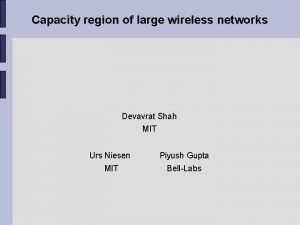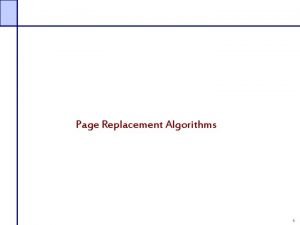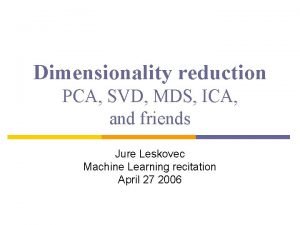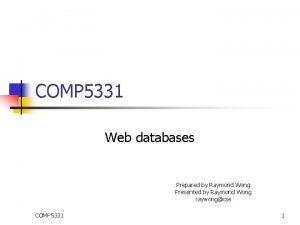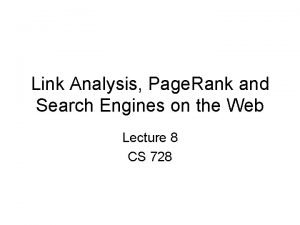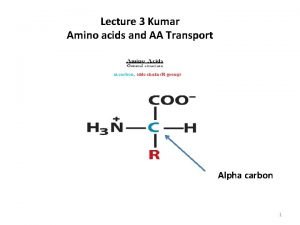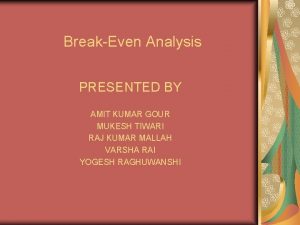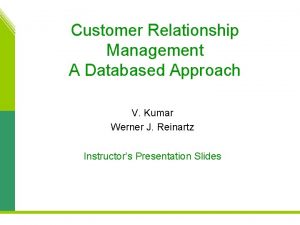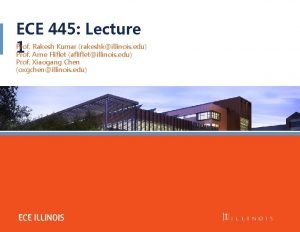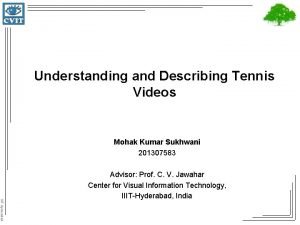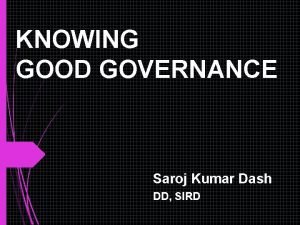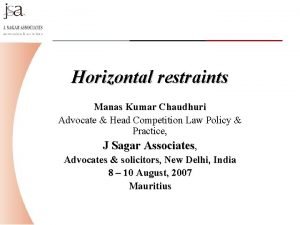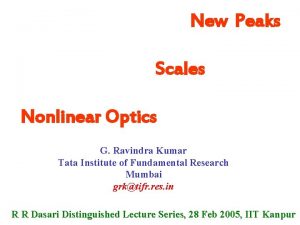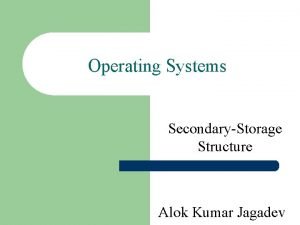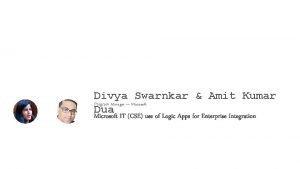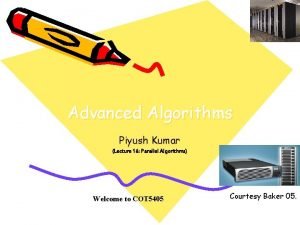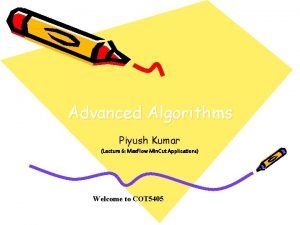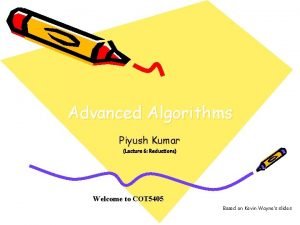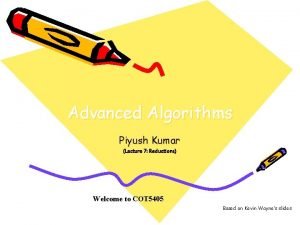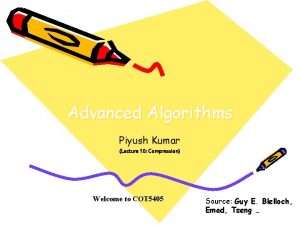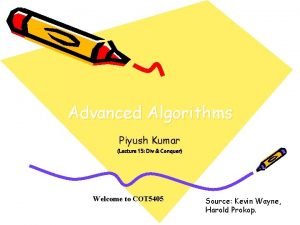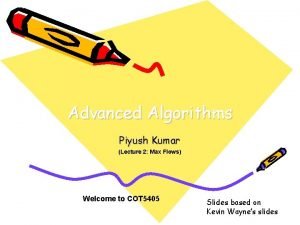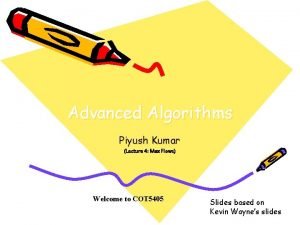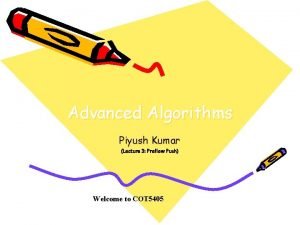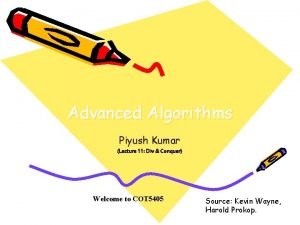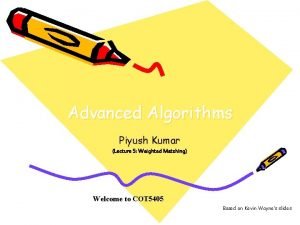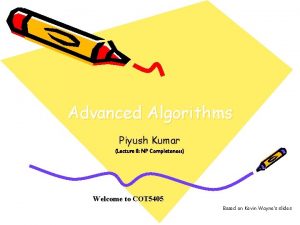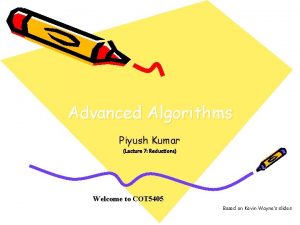Advanced Algorithms Piyush Kumar Lecture 5 Page Rank






![1. 2 Operations of matrices Matrix multiplication §If A = [aij] is a m 1. 2 Operations of matrices Matrix multiplication §If A = [aij] is a m](https://slidetodoc.com/presentation_image/7c55b4ede8a6aaf4032105666004817f/image-7.jpg)












































- Slides: 51

Advanced Algorithms Piyush Kumar (Lecture 5: Page. Rank) Welcome to COT 5405

Quick Recap: Linear Algebra Matrices Source: http: //www. phy. cuhk. edu. hk/phytalent/mathphy/

1. 1 Matrices Square matrices §When m = n, i. e. , 3

1. 2 Operations of matrices Sums of matrices Example: if and Evaluate A + B and A – B. 4

1. 2 Operations of matrices Scalar multiplication Example: . Evaluate 3 A. 5

1. 2 Operations of matrices Properties Matrices A, B and C are conformable, §A + B = B + A (commutative law) §A + (B +C) = (A + B) +C (associative law) §l(A + B) = l. A + l. B, where l is a scalar (distributive law) Can you prove them? 6
![1 2 Operations of matrices Matrix multiplication If A aij is a m 1. 2 Operations of matrices Matrix multiplication §If A = [aij] is a m](https://slidetodoc.com/presentation_image/7c55b4ede8a6aaf4032105666004817f/image-7.jpg)
1. 2 Operations of matrices Matrix multiplication §If A = [aij] is a m p matrix and B = [bij] is a p n matrix, then AB is defined as a m n matrix C = AB, where C= [cij] with for 1 i m, 1 j n. Example: Evaluate c 21. , and C = AB. 7

1. 2 Operations of matrices Matrix multiplication Example: , , Evaluate C = AB. 8

1. 2 Operations of matrices Properties Matrices A, B and C are conformable, §A(B + C) = AB + AC §(A + B)C = AC + BC However §A(BC) = (AB) C §AB BA in general §AB = 0 NOT necessarily imply A = 0 or B = 0 §AB = AC NOT necessarily imply B = C 9

Identity Matrix Examples of identity matrices: and

1. 3 Types of matrices The transpose of a matrix §The matrix obtained by interchanging the rows and columns of a matrix A is called the transpose of A (write AT). Example: The transpose of A is §For a matrix A = [aij], its transpose AT = [bij], where bij = aji. 11

1. 3 Types of matrices The inverse of a matrix §If matrices A and B such that AB = BA = I, then B is called the inverse of A (symbol: A-1); and A is called the inverse of B (symbol: B-1). Example: Show B is the inverse of matrix A. Ans: Note that Can you show the details? 12

1. 3 Types of matrices Symmetric matrix §A matrix A such that AT = A is called symmetric, i. e. , aji = aij for all i and j. §A + AT must be symmetric. Why? Example: is symmetric. §A matrix A such that AT = -A is called skewsymmetric, i. e. , aji = -aij for all i and j. §A - AT must be skew-symmetric. Why? 13

1. 4 Properties of matrix §(AB)-1 = B-1 A-1 §(AT)T = A and (l. A)T = l AT §(A + B)T = AT + BT §(AB)T = BT AT 14

The determinant of a 2 × 2 matrix: n Note: 1. For every square matrix, there is a real number associated with this matrix and called its determinant 2. It is common practice to delete the matrix brackets 3. 15 Source: http: //www. management. ntu. edu. tw/~jywang/course/

Historically, the use of determinants arose from the recognition of special patterns that occur in the solutions of linear systems: n Note: 1. a 11 a 22 - a 21 a 12≠ 0 2. x 1 and x 2 have the same denominator, and this quantity is called the determinant of the coefficient matrix A 3. 16

Ex. 1: (The determinant of a matrix of order 2) n Note: The determinant of a matrix can be positive, zero, or negative 3. 17

1. 5 Determinants The following properties are true for determinants of any order. 1. If every element of a row (column) is zero, e. g. , 2. |AT| = |A| , then |A| = 0. determinant of a matrix = that of its transpose 3. |AB| = |A||B| 18

Eigenvalues and Eigenvectors Ax = λx Should not exist? det(A − λI) = 0. Fact: A and transpose(A) have the same eigenvalues. Why?

Page Ranking

Task of search engines Crawl Build indices so that one can search keywords efficiently. Rate the importance of pages. One example is the simple algorithm named pagerank.

The basic idea Mimic democracy! Use the brains of all people collectively.

The basic idea Mimic democracy! Use the brains of all people collectively for the ranking. What’s wrong with counting backlinks? Should page 1 be ranked above page 4?

Voting using backlinks? But then we don’t want an individual to cast more than one vote? Normalize?

Normalized Voting?

Link Matrix (for the given web):

Link Matrix (for the given web): Most important node = 1?

Definition A square matrix is called column stochastic if all of its entries are non-negative and the entries in each column sum to 1. Lemma: Every column stochastic matrix has 1 as an eigenvalue. Proof: A and A’ = transpose of A, have the same eigenvalues: Why?

Two shortcomings Nonunique Rankings. Dangling nodes : Nodes with no outgoing edges. The matrix is no longer column stochastic. Can we transform it into one easily?

Nonunique Rankings Not clear: Which linear combination should we pick for the ranking?

Nonunique Rankings

Nonunique Rankings

Modification of the Link Matrix The value of m used by google (1998) was. 15 For any m between 0, 1; M is column stochastic. M can be used to compute unambiguous importance scores (in the absence of dangling nodes) For m = 1, the only normalized eigenvector with eigenvalue 1 is ?

Modification of the Link Matrix

Example 1 For our first example graph, m = 0. 15.

Example 2 Still, m = 0. 15.

Towards the proof Proof by Contradiction? -> Let x be an eigenvector with mixed signs for the eigenvalue 1. For real numbers

Towards the proof

A punchline

The Algorithm (aka Power Method)

c?

One last lemma…

Why does it converge?

The main theorem For figure 2:

First Example Do we need any modifications to A?

Calculations

Another Example

Random Surfer Model The 85 -15 Rule: Assume that 85 per cent of the time the random surfer clicks a random link on the current page (each link chosen with equal probability) 15 percent of the time the random surfer goes directly to a random page (all pages on the web chosen with equal probability).

Random Surfer Model Cons No one chooses links or pages with equal probability. There is no real potential to surf directly to each page on the web. The 85 -15 (or any fixed) breakdown is just a guess. Back Button? Bookmarks? Despite these flaws, the model is good enough that we have learnt a great deal about the web using it.

Related stuff to explore Random walks and Markov Chains. Random Graph construction using Random walks. Absorbing Markov Chains. Ranking with not too many similar items at the top. Dynamical Systems point of view. Equilibrium or Stationary Distributions. Rate of convergence. Perron-Frobenius Theorem Intentional Surfer model. Markov Chain Slides: http: //www. math. dartmouth. edu/archive/m 20 x 06/public_html/Lecture 13. pdf http: //www. math. dartmouth. edu/archive/m 20 x 06/public_html/Lecture 14. pdf http: //www. math. dartmouth. edu/archive/m 20 x 06/public_html/Lecture 15. pdf

Homework 1 Implementation: Parse wikipedia pages and find pageranks of top 1000 pages of the given input. (TBA) Theory: Solve Exercises in the given paper. (Online) There are 24 questions in total in the paper (including subproblems marked with a filled disc, Example, problem 6 has 3 subproblems). Pick the first two characters of your fsu. edu email address. Example “pk” for pkumar@fsu. edu. (all lowercase) Represent in hex : “ 706 B” = x = Your hex number goes here. Calculate f 1 = ((x mod 3 D) mod 18)+1 Calculate f 2 = (f 1 + 12) mod 18 Solve those two exercises in the paper. Write the problems you solve (including problem numbers) and the solution in Latex. Submit.
 Dr piyush jain rml hospital
Dr piyush jain rml hospital Piyush gupta mit
Piyush gupta mit Introduction to algorithms lecture notes
Introduction to algorithms lecture notes Analysis of algorithms lecture notes
Analysis of algorithms lecture notes Interpolation search formula
Interpolation search formula Clock sweep algorithm
Clock sweep algorithm Google page rank algorithm
Google page rank algorithm Google page rank algorithm
Google page rank algorithm Google page rank
Google page rank Pagerank history
Pagerank history Pagerank random walk
Pagerank random walk Google page rank algorithm
Google page rank algorithm Page rank
Page rank Rankmap
Rankmap Page rank nedir
Page rank nedir Page rank centrality
Page rank centrality Pagerank teleportation
Pagerank teleportation 01:640:244 lecture notes - lecture 15: plat, idah, farad
01:640:244 lecture notes - lecture 15: plat, idah, farad Advanced inorganic chemistry lecture notes
Advanced inorganic chemistry lecture notes Header apa format
Header apa format Kamal kumar ips
Kamal kumar ips Bedford interview skills
Bedford interview skills Kumar
Kumar Col 106 amit kumar
Col 106 amit kumar Dr. vijay kumar
Dr. vijay kumar Jay kumar kar
Jay kumar kar Kumar
Kumar Srinidhi sampath kumar
Srinidhi sampath kumar Customer relationship management kumar
Customer relationship management kumar Kumar n. sivarajan
Kumar n. sivarajan Kumar mangalam birla committee
Kumar mangalam birla committee Kumar
Kumar Uiuc cs 445
Uiuc cs 445 Mahendra kumar fiji
Mahendra kumar fiji Mohak kumar
Mohak kumar Dr adarsh kumar national heart institute
Dr adarsh kumar national heart institute Vinoth kumar meaning
Vinoth kumar meaning Dr santosh kumar swain
Dr santosh kumar swain Rajesh kumar bhagat
Rajesh kumar bhagat Eprg
Eprg Saroj kumar dash
Saroj kumar dash Circumstanstial
Circumstanstial Kumar samrudhi society
Kumar samrudhi society Kumar is producing the photoelectric effect by using
Kumar is producing the photoelectric effect by using Manas kumar chaudhuri
Manas kumar chaudhuri G ravindra kumar
G ravindra kumar Alok kumar jagadev
Alok kumar jagadev Dr v kumar
Dr v kumar Col 106 amit kumar
Col 106 amit kumar Kumar satish ravi
Kumar satish ravi Microsoft dua
Microsoft dua Senthil kumar palanisamy
Senthil kumar palanisamy

